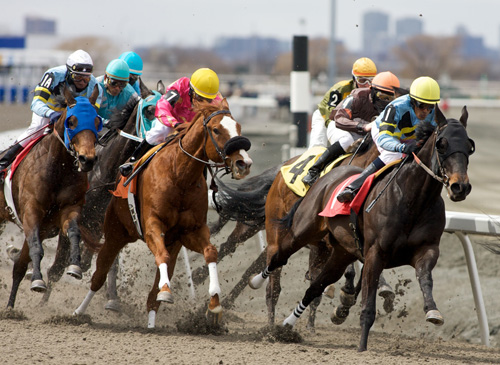 Enhancing safety is a major concern for everyone involved in the horse racing industry, but until recently there has not been systematic research into how racetracks might be made safer for the horses that run on them.
Enhancing safety is a major concern for everyone involved in the horse racing industry, but until recently there has not been systematic research into how racetracks might be made safer for the horses that run on them.
Biomedical sciences professor Jeff Thomason is helping to change that. He’s one of five co-authors of a recently-released Racing Surfaces White Paper (available for downloading at grayson-jockeyclub.org/resources/White_Paper_final.pdf) that pulled together the most current research on the horse-hoof-track interactions. The paper outlines what we know about how the horse’s feet and legs move while galloping and how different track types affect that movement.
It also reveals that there is much that we don’t know – yet. There are many factors involved in understanding the mechanics of a horse running on different surfaces and it’s not easy to sort them out. The paper did, however, provide a series of questions that can be answered by specific research studies. “It’s only by meticulously piecing together the answers of each precise question that you begin to see the big picture,” says Thomason.
Thomason’s research, funded by the Natural Sciences and Engineering Research Council of Canada, Equine Guelph and the Grayson Jockey Club, focuses on the mechanics of the horse’s movements, and the level of strain and shock experienced at each point in the horse’s stride. He became a familiar sight at Woodbine Racetrack last year when he and his fellow researchers carefully applied lightweight sensors to various parts of the horses’ hooves, allowing them to measure the forces as the horses raced.
He describes the interaction of the horse’s hoof and the ground into four component parts, each with its own levels of force and shock, and association with common injuries.
Phase one (primary impact – concussion): the hoof collides with the ground. While a lot of attention is focussed on concussion, Thomason says that the forces are effectively absorbed by the horse’s foot.
Phase two (slide and stop): the hoof slides forward along the ground and then comes to a stop. The risks during this part of the stride are that the large bone in the horse’s leg may bend more than normal, or that muscles may tear due to the strain on them. Little is known about the importance of this phase for injury.
Phase three (support): there is a high level of strain here as well as the leg moves to the vertical position and the weight of the horse’s fast-moving body is all on one leg and hoof. The peak load can be 2.5 times the bodyweight of the horse. Many injuries – fractured bones, ruptured tendons – are related to this extreme loading.
Phase four (rollover): the heel of the horse’s hoof leaves the ground and the hoof “unrolls” and pushes off into the next stride. There is a risk of injury to the tendons as the hoof is flicked back, and muscle fatigue is a factor in injuries during this phase as well.
By analyzing these phases, Thomason and his fellow researchers can predict what kinds of injuries are most likely during different parts of the stride, and how the different track surfaces affect the rates.
In the phase two “slide and stop” part of the stride, for example, it’s important that the hoof doesn’t slide too far or stop too soon. A track that is too hard or shoes that grab too much can make the slide part of the stride too short and cause injury, Thomason says.
So what kind of track is safest? Consistency of the surface seems to be more important than the material it is made of, according to Thomason. Not only does the track need to be well-constructed to start with, but good maintenance is required to keep the surface consistent – including light harrowing between races. Variation in moisture content – during the day or with local climate – is another factor: tracks can become too wet in places or dry out too much in hot weather.
There also needs to be an appropriate match between the type of shoe the horse is wearing and the track (some shoes act as more of a brake when the hoof hits the ground than others), so that the forces on the horse’s feet and legs are minimized.
Thomason will continue to be involved in this collaborative research and intends to explore some of the questions raised in this White Paper so that definite answers can be provided about the links between safety, and the track materials and construction. “This White Paper is the most comprehensive scientific body of research on race tracks to date, yet it is just scratching the surface,” he says.
